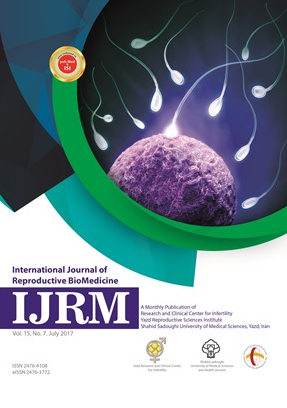
International Journal of Reproductive BioMedicine
ISSN: 2476-3772
The latest discoveries in all areas of reproduction and reproductive technology.
Fresh embryo transfer in the cleavage and blastocyst stages and pregnancy outcomes: A retrospective cross-sectional study
Published date:Jun 10 2023
Journal Title: International Journal of Reproductive BioMedicine
Issue title: International Journal of Reproductive BioMedicine (IJRM): Volume 21, Issue No. 5
Pages:425 - 432
Authors:
Abstract:
Background: Advances in cell culture media have led to a trend of embryo transfer from the early cleavage stages to blastocyst stage.
Objective: The study aims to compare the effects of fresh embryo transfer in cleavage and blastocyst stage on pregnancy outcomes.
Materials and Methods: This cross-sectional study was conducted on 1422 cases referred to the Umm-al-Banin Infertility Clinic Center, Dezful, Iran, between July 2013 and December 2020 who were candidates for in vitro fertilization/intracytoplasmic sperm injection for fresh embryo transfer. A total of 1246 cases were divided into 4 categories on days 2-5 or 6. Chemical and clinical pregnancy, abortion, multifetal pregnancy, ongoing pregnancy, and live birth rates were analyzed.
Results: Fresh embryo transfer was performed in 28.5% of the cases on the 2nd day, 45.8% on the 3rd, 15.3% on the 4th day, and 10.4% on days 5 or 6. The overall clinical pregnancy and live birth rates were estimated at 20.6% and 17.6% in the cleavage, and 17% and 14% in the blastocyst stages, respectively. However, no significant difference was observed in either group. In addition, there was no significant difference between groups in terms of the abortion, multifetal pregnancy, and ongoing pregnancy rate (p > 0.05).
Conclusion: According to the results, the consequences of pregnancy in fresh embryo transfer at the blastocyst stage were not superior to embryo transfer at different stages of the cleavage process.
Key words: Embryo transfer, Cleavage, Blastocyst, Pregnancy outcomes.
References:
[1] Dehghani Firouzabadi R, Janati S, Razi MH. The effect of intrauterine human chorionic gonadotropin injection before embryo transfer on the implantation and pregnancy rate in infertile patients: A randomized clinical trial. Int J Reprod BioMed 2016; 14: 657–664.
[2] Neuhausser WM, Vaughan DA, Sakkas D, Hacker MR, Toth T, Penzias A. Non-inferiority of cleavage-stage versus blastocyst-stage embryo transfer in poor prognosis IVF patients (PRECiSE trial): Study protocol for a randomized controlled trial. Reprod Health 2020; 17: 16.
[3] Eftekhar M, Janati S, Rahsepar M, Aflatoonian A. Effect of oocyte activation with calcium ionophore on ICSI outcomes in teratospermia: A randomized clinical trial. Iran J Reprod Med 2013; 11: 875.
[4] Martins WP, Nastri CO, Rienzi L, Van Der Poel SZ, Gracia C, Racowsky C. Blastocyst vs cleavage-stage embryo transfer: Systematic review and meta-analysis of reproductive outcomes. Ultrasound Obstet Gynecol 2017; 49: 583–591.
[5] Fragouli E, Alfarawati S, Spath K, Wells D. Morphological and cytogenetic assessment of cleavage and blastocyst stage embryos. Mol Hum Reprod 2014; 20: 117–126.
[6] Brown J, Daya S, Matson P. Day three versus day two embryo transfer following in vitro fertilization or intracytoplasmic sperm injection. Cochrane Database Syst Rev 2016; 12: CD004378.
[7] Poormoosavi SM, Behmanesh MA, Najafzadeh Varzi H, Mansouri Sh, Janati S. The effect of follicular fluid selenium concentration on oocyte maturation in women with polycystic ovary syndrome undergoing in vitro fertilization/ intracytoplasmic sperm injection: A cross-sectional study. Int J Reprod BioMed 2021; 19: 689–698.
[8] Hill GA, Freeman M, Bastias MC, Rogers BJ, Herbert CM, Osteen KG, et al. The influence of oocyte maturity and embryo quality on pregnancy rate in a program for in vitro fertilization-embryo transfer. Fertil Steril 1989; 52: 801– 806.
[9] Gardner DK, Schoolcraft WB. Culture and transfer of human blastocysts. Curr Opin Obstet Gynecol 1999; 11: 307–311.
[10] Davar R, Poormoosavi SM, Mohseni F, Janati S. Effect of embryo transfer depth on IVF/ICSI outcomes: A randomized clinical trial. Int J Reprod BioMed 2020; 18: 723–732.
[11] Sotiroska V, Petanovski Z, Dimitrov G, Hadji-Lega M, Shushleski D, Saltirovski S, et al. The day of embryo transfer affects delivery rate, birth weights, female-to-male ratio, and monozygotic twin rate. Taiwan J Obstet Gynecol 2015; 54: 716–721.
[12] Ozgur K, Berkkanoglu M, Bulut H, Humaidan P, Coetzee K. Perinatal outcomes after fresh versus vitrified-warmed blastocyst transfer: Retrospective analysis. Fertil Steril 2015; 104: 899–907.e3.
[13] Zhu Q, Zhu J, Wang Y, Wang B, Wang N, Yin M, et al. Live birth rate and neonatal outcome following cleavagestage embryo transfer versus blastocyst transfer using the freeze-all strategy. Reprod Biomed Online 2019; 38: 892– 900.
[14] Clua E, Rodríguez I, Arroyo G, Racca A, Martínez F, Polyzos NP. Blastocyst versus cleavage embryo transfer improves cumulative live birth rates, time and cost in oocyte recipients: A randomized controlled trial. Reprod BioMed Online 2022; 44: 995–1004.
[15] De Vos A, Van Landuyt L, Santos-Ribeiro S, Camus M, Van de Velde H, Tournaye H, et al. Cumulative live birth rates after fresh and vitrified cleavage-stage versus blastocyststage embryo transfer in the first treatment cycle. Hum Reprod 2016; 31: 2442–2449.
[16] Holden EC, Kashani BN, Morelli SS, Alderson D, Jindal SK, Ohman-Strickland PA, et al. Improved outcomes after blastocyst-stage frozen-thawed embryo transfers compared with cleavage stage: A society for assisted reproductive technologies clinical outcomes reporting system study. Fertil Steril 2018; 110: 89–94. e2.
[17] Cameron N, Bhattacharya S, McLernon D. Cumulative live birth rates following blastocyst-versus cleavage-stage embryo transfer in the first complete cycle of IVF: A population-based retrospective cohort study. Hum Reprod 2020; 35: 2365–2374.